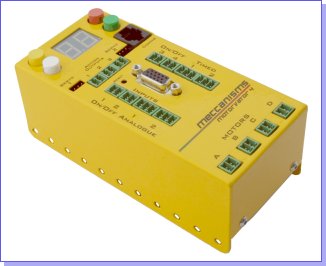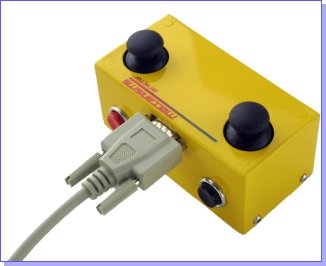|
Meccanisms MotorVator By Andrew Wells |
| |
||||
| |
Control your Meccano models (or anything else) from your Windows PC!
Take a look at my new MECControl project at meccontrol.com
Advertisement Feature
The Meccanisms MotorVator™ is an electronic controller that can be used to drive a wide range of devices to bring your Meccano model to life. The MotorVator controls Motors, Servo Motors and Relays, and uses input from a wide range of sensors including switches, proximity, rotation, angle and temperature.
The Meccanisms MotorVator
| Enlarge to 800x650 |
The MotorVator operates in two modes. With the optional Director handheld control console, the MotorVator translates your inputs on the Director's joysticks and buttons into control signals for the Motors, Servo Motors and Relay Outputs. A range of pre-programmed modes allow you to choose the best match up of input movements to devices, so that you get real-life realism in the control of your model. For example, a block setter crane could employ four motors and match these to the four axes of the two joysticks: Left Joystick Up/Down = luff, Left Joystick Left/Right = base travel, Right Joystick Up/Down = hook, Right Joystick Left/Right = Slew. Add on a relay- or Servo Motor-driven grab or electromagnet activated by one of the buttons and you have the same operating conditions as a modern prototype crane.
The second, and more powerful mode of operation uses the programming capability of the MotorVator. Through the MotorVate programming language, the MotorVator can use any of the inputs to create an 'intelligent' sequence of controls.
For example, a four axis robot arm might be programmed to repeat the steps required to 'solve' the Tower of Hanoi disk puzzle. Each Disk movement becomes a sequence of "Rotate base to left pile", "lower arm to Disk #", "Close grab", "Raise arm above piles", "Rotate base to new pile", "lower arm", "open Grab" etc. The logic to perform each of these tasks is then built up using the commands that match your model.
So "Lower Arm by Fifteen Degrees" might be written as...
| Clear Byte | Counter | |||||
| Set Motor 1 | Forward | Slow_speed | ||||
| Keep_Counting: | Read Pulse Count | 1 | Arm_Degree_Sensor | |||
| Add Byte | Counter | Arm_Degree_Sensor | ||||
| If Byte Less Than | Counter 14 | Keep_Counting | ||||
| Stop Motor 1 |
You quickly build up "Routines" like this that can be re-used in your program.
The instruction set of the MotorVate programming language is very powerful. Each instruction above takes a maximum of seven bytes of storage, so you can fit a very complex program into the 24kb of program storage available.
You write your program of instructions on a Windows™ PC, then download the program to the MotorVator. Once downloaded, the MotorVator runs the program itself, so you can leave the PC at home and still have your program running at a meeting or exhibition.
The Director hand-held
control console
| Enlarge to 800x650 |
Specifications
- 4 pulse width modulated (PWM) (speed and direction controllable) motor outputs, each rated at 1A continuous.
- 2 servo motor drivers (180 degree travel, with 1 degree accuracy).
- 3 relay drivers (250mA drive).
- 6 analogue inputs (0 to 5V range).
- 8 digital inputs.
- 3 different voltage inputs, to allow you to operated motors of different voltages concurrently.
- Steel case with Meccano-compatible mounting holes. Strong enough to be used as an integral component in your model.
- Powder coated in Traditional Red or Modern Yellow.
- MotorVate software environment requires Windows PC, 7Mb of hard disk space and a standard serial port.
- 184 page manual included.
For further information, please visit www.meccanisms.com
Purchasing
The Meccanisms range is currently available via mail/internet for worldwide shipment from www.meccparts.com - P.O. Box 26-179, Epsom, Auckland 1003, New Zealand.
|
|
| Article Information |
Top of Page | Homepage | About | Search | Topics | Features | Circuits Shop | yourEiM |
© 1998 - 2024 Tim Surtell |

